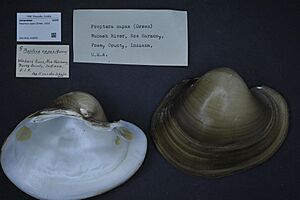Fat pocketbook pearly mussel facts for kids
Quick facts for kids Fat pocketbook pearly mussel |
|
|---|---|
 |
|
| Conservation status | |
| Scientific classification | |
| Genus: |
Potamilus
|
| Species: |
capax
|
The fat pocketbook (scientific name: Potamilus capax) is a special type of freshwater mussel. It's an animal that lives in water and has a two-part shell, just like clams. This mollusk belongs to the family Unionidae, which are also known as river mussels.
About the Fat Pocketbook Mussel
The fat pocketbook is a large freshwater mussel. It needs flowing water to live. It also needs a stable place to attach itself. Scientists are still studying exactly what kind of ground it likes best. It probably prefers a mix of sand, silt, and clay. This mussel is quite similar to other native freshwater mussels. Its life cycle and how it reproduces are much like other mussels.
Where Do They Live?
Today, you can find fat pocketbook mussels in a small part of the St. Francis River. This river is in St. Francis County, Arkansas. They used to live in the Mississippi River. However, they are no longer found there. This is because the river has been changed for boats. It is also regularly dug out to keep a deep shipping channel. A similar thing happened in the St. Francis Floodway. In the White River in Arkansas, the moving sand bars no longer offer a stable home for these mussels.
Why Are They in Trouble?
The number of fat pocketbook mussels has gone down a lot. In the past, building things for boats and controlling floods caused big problems. These activities changed the rivers where the mussels lived. Now, their population is still shrinking. This is due to work on canals. Also, changes in water temperature and how water flows are a big threat. Building dams and other barriers on rivers also harms them. These changes make it very hard for the fat pocketbook mussel to survive.


